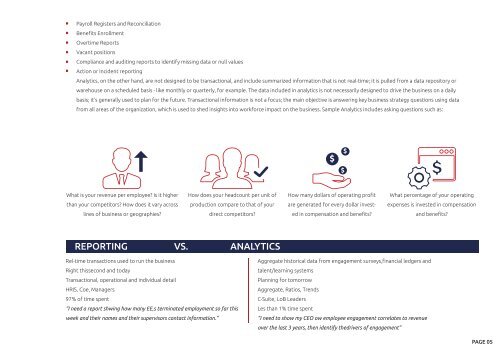QM E-Book New Version Long New 3
You also want an ePaper? Increase the reach of your titles
YUMPU automatically turns print PDFs into web optimized ePapers that Google loves.
• Payroll Registers and Reconciliation<br />
• Benefits Enrollment<br />
• Overtime Reports<br />
• Vacant positions<br />
• Compliance and auditing reports to identify missing data or null values<br />
• Action or Incident reporting<br />
Analytics, on the other hand, are not designed to be transactional, and include summarized information that is not real-time; it is pulled from a data repository or<br />
warehouse on a scheduled basis - like monthly or quarterly, for example. The data included in analytics is not necessarily designed to drive the business on a daily<br />
basis; it’s generally used to plan for the future. Transactional information is not a focus; the main objective is answering key business strategy questions using data<br />
from all areas of the organization, which is used to shed insights into workforce impact on the business. Sample Analytics includes asking questions such as:<br />
$<br />
$<br />
$<br />
What is your revenue per employee? Is it higher<br />
How does your headcount per unit of<br />
How many dollars of operating profit<br />
What percentage of your operating<br />
than your competitors? How does it vary across<br />
production compare to that of your<br />
are generated for every dollar invest-<br />
expenses is invested in compensation<br />
lines of business or geographies?<br />
direct competitors?<br />
ed in compensation and benefits?<br />
and benefits?<br />
REPORTING VS. ANALYTICS<br />
Rel-time transactions used to run the business<br />
Right thissecond and today<br />
Transactional, operational and individual detail<br />
HRIS, Coe, Managers<br />
97% of time spent<br />
“I need a report shwing how many EE,s terminated employment so far this<br />
week and their names and their supervisors contact information.”<br />
Aggregate historical data from engagement surveys,financial ledgers and<br />
talent/learning systems<br />
Planning for tomorrow<br />
Aggregate, Ratios, Trends<br />
C-Suite, LoB Leaders<br />
Les than 1% time spent<br />
“I need to show my CEO ow employee engagement correlates to revenue<br />
over the last 3 years, then identify thedrivers of engagement”<br />
PAGE XX 05


